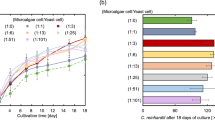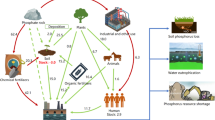Abstract
The effect of carbon∶nitrogen∶phosphorus (C∶N∶P) ratio of organic substrates on the regeneration of ammonium and phosphate was investigated by growing natural assemblages of freshwater bacteria in mineral media supplemented with the simple organic C, N, and P sources (glucose, asparagine, and sodium glycerophosphate, respectively) to give 25 different substrate C∶N∶P ratios. Both ammonium and phosphate were regenerated when C∶N and N∶P atomic ratios of organic substrates were ≤10∶1 and ≤16∶1, respectively. Only ammonium was regenerated when C∶N and N∶P ratios were ≤10∶1 and ≥10–20∶1, respectively. On the other hand, neither ammonium nor phosphate was regenerated when C∶N and N∶P ratios were ≥15∶1 and ≥5∶1, respectively. In no case was phosphate alone regenerated. As bacteria were able to alter widely the C∶N∶P ratio of their biomass, the growth yield of bacteria appeared primarily dependent on the substrate carbon concentration, irrespective of a wide variation in the substrate C∶N∶P ratio.
Similar content being viewed by others
References
Alexander M (1961) Introduction to soil microbiology. John Wiley & Sons, New York and London
Andersen OK, Goldman JC, Caron DA, Dennett MR (1986) Nutrient cycling in a microflagellate food chain: III. Phosphorus dynamics. Mar Ecol Prog Ser 31:47–55
Ausmus BS, Edwards NT, Witkamp M (1976) Microbial immobilization of carbon, nitrogen and potassium: implications for forest ecosystem processes. In: Anderson JM, Macfadyen A (eds) The role of terrestrial and aquatic organisms in decomposition processes. Blackwell Scientific Publications, Oxford, pp 397–416
Bloem J, Starink M, Bär-Gillissen MJB, Cappenberg TE (1988) Protozoan grazing, bacterial activity, and mineralization in two-stage continuous cultures. Appl Environ Microbiol 54:3113–3121
Bloem J, Albert C, Bär-Gillissen MJB, Berman T, Cappenberg TE (1989) Nutrient cycling through phytoplankton, bacteria and protozoa, in selectively filtered Lake Vechten water. J Plankton Res 11:119–131
Bower CE, Holm-Hansen T. (1980) A salicylate-hypochlorite method for determining ammonia in seawater. Can J Fish Aquat Sci 37:794–798
Bratbak G (1985) Bacterial biovolume and biomass estimations. Appl Environ Microbiol 49:1488–1493
Caron DA, Goldman JC, Dennett MR (1986) Effect of temperature on growth, respiration, and nutrient regeneration by an omnivorous microflagellate. Appl Environ Microbiol 52:1340–1347
Caron DA, Goldman JC, Dennett MR (1988) Experimental demonstration of the roles of bacteria and bacterivorous protozoa in plankton nutrient cycles. Hydrobiologia 159:27–40
Fenchel T, Harrison P (1976) The significance of bacterial grazing and mineral cycling for the decomposition of particulate detritus. In: Anderson JM, Macfadyen A (eds) The role of terrestrial and aquatic organisms in decomposition processes. Blackwell Scientific Publications, Oxford, pp 285–299
Fenchel T, Blackburn TH (1979) Bacteria and mineral cycling. Academic Press, London
Goldman JC, Caron DA, Dennett MR (1987) Regulation of gross growth efficiency and ammonium regeneration in bacteria by substrate C∶N ratio. Limnol Oceanogr 32:1239–1252
Güde H (1985) Influence of phagotrophic processes on the regeneration of nutrients in two-stage continuous culture systems. Microb Ecol 11:193–204
Johannes RE (1965) Influence of marine protozoa on nutrient regeneration. Limnol Oceanogr 10:434–442
Menzel DW, Corwin N (1965) The measurement of total phosphorus in seawater based on the liberation of organically bound fraction by persulfate oxidation. Limnol Oceanogr 10:280–282
Murphy J, Riley JP (1962) A modified single solution method for determination of phosphate in natural waters. Anal Chim Acta 27:31–36
Sherr BF, Sherr EB, Berman T (1983) Grazing, growth, and ammonium excretion rates of a heterotrophic microflagellate fed with four species of bacteria. Appl Environ Microbiol 45:1196–1201
Tezuka Y (1984) Seasonal variations of dominant phytoplankton, chlorophylla and nutrient levels in the pelagic regions of Lake Biwa. Jpn J Limnol 45:26–37
Tezuka Y (1985) C∶N∶P ratios of seston in Lake Biwa as indicators of nutrient deficiency in phytoplankton and decomposition process of hypolimnetic particulate matter. Jpn J Limnol 46:239–246
Tezuka Y (1986) Does the seston of Lake Biwa release dissolved inorganic nitrogen and phosphorus during aerobic decomposition?: its implication for eutrophication. Ecol Res 1:293–302
Tezuka Y (1989a) The C∶N∶P ratio of phytoplankton determines the relative amounts of dissolved inorganic nitrogen and phosphorus released during aerobic decomposition. Hydrobiologia 173:55–62
Tezuka Y (1989b) The C∶N∶P ratio ofMicrocystis andAnabaena (blue-green algae) and its importance for nutrient regeneration by aerobic decomposition. Jpn J Limnol 50:149–155
Uehlinger U (1986) Bacteria and phosphorus regeneration in lakes. An experimental study. Hydrobiologia 135:197–206
Author information
Authors and Affiliations
Rights and permissions
About this article
Cite this article
Tezuka, Y. Bacterial regeneration of ammonium and phosphate as affected by the carbon:nitrogen:phosphorus ratio of organic substrates. Microb Ecol 19, 227–238 (1990). https://doi.org/10.1007/BF02017167
Issue Date:
DOI: https://doi.org/10.1007/BF02017167




